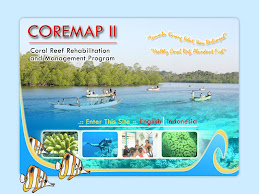Background
Our future depends on coastal and marine ecosystems. They serve the indispensable role of feeding human populations and are essential in climate cycles and other global processes that sustain life. Being an archipelagic state located in a tropic region, Indonesian coastal and marine ecosystems are home to a vast array of flora and fauna, from a wider range of taxonomic groups than on land, constituting a huge pool of marine biodiversity (mega-biodiversity).
The existence of marine biodiversity and its ecosystem is essential for development; and; in addition, as an intrinsic part of the culture, not just of tribal and coastal people but also as a vital part of the natural and cultural heritage of the world.
Special zones are mainly concentrated in small areas of coral reefs, sea-grass beds and mangroves around the coasts, which provide rich feeding and breeding grounds for fish. Coral reefs are particularly at risk, from global warming, mining for building materials, land-based pollution and siltation, over-fishing, destructive fishing and unregulated tourism. While such areas are small in comparison with the open seas, they are the most diverse and threatened, they are as well as the source of many livelihoods of coastal communities.
Based on the facts above, marine biodiversity and its ecosystem are facing serious degradation, therefore, attempts to restore their natural condition, as well as the sustainability of marine biodiversity and its ecosystems, is mandatory.
This is true as the dichotomy between utilization and conservation prevails. For the future, we should leave such old thinking behind. Conservation efforts play an integral part in the restoration of natural conditions for marine biodiversity and its ecosystems. At the same time, the natural resources from coastal and marine regions are very important assets for the development of the nation. Consequently, they may be cautiously exploited by taking into account the principals of perpetual and sustainability use.
In agreement with statement above, the vision, missions and strategies are designed to achieve the conservation as well as utilization in harmony.
Vision
Perpetual marine biodiversity and its ecosystems for the welfare of the nation
Missions
a. Optimal protection, conservation, and utilization of marine biodiversity and its ecosystems.
b. Building of awareness and a sense of responsibility in order to secure the role of the stakeholders in perpetuating marine biodiversity and its ecosystems
c. Optimization of the functions and utilization of marine biodiversity and its ecosystems in sustainable manner towards the welfare of the Indonesian people
Strategies
a. Improvement and development of programs for conservation of marine biodiversity and its ecosystems.
b. Upgrading the human resources capacity and other resources taking into account the local knowledge.
c. Strengthening institutional capacity and law enforcement.
d. Expanding cooperation and networking among stakeholders.
e. Monitoring, controlling, and surveillance for conservation of marine biodiversity and its ecosystems.
(c) coremap ii - dkp
Sabtu, Desember 23, 2006
Langganan:
Posting Komentar (Atom)





Tidak ada komentar:
Posting Komentar